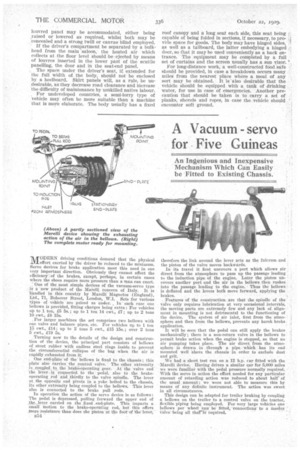A Vacuum servo
Page 80

If you've noticed an error in this article please click here to report it so we can fix it.
for Five Guineas
An Ingenious and Inexpensive Mechanism Which Can Easily be Fitted to Existing Chassis.
MODERI'i driving conditions demand that the physical effort exerted by the driver he reduced to the minimum. servo devices for brake application meet this need in one very important direction. Obviously they cannot affect the efficiency of the brakes, except, perhaps, in certain cases where the shoes require more pressure than a roan can exert. One of the most simple devices of the vacuum-servo type is a new product of the Marelli concern of Italy. It is 'handled in this country by Marelli Magnetos (England), Ltd., 71, Bolsover Street, London, WI . Sets for various types of vehicle are priced as under. _ ln each case one bellows is provided, fitting charges being extra : For vehicles up to 1 ton, /5 fie.; up to 1 ton 14 Cwt., £7; up to 2 tons 10 cwt., iS 15s.
, For larger machines the set comprises two bellows with one valve and balance pipes, ete. For vehicles up to 1 ton 15 cwt., £14; up to 2 tons 5 cwt., £15 15s.; over 2 tons 5 cwt., £19 5s.
Turning now to the details of the design and construction of the device, the principal part consists of bellows of stout rubber with endless steel rings inside to prevent the circumferential collapse of the bag when the air is rapidly exhausted from it
. One end-plate of the' bellows is fixed to the chassis; this plate also carries the control valve. The other extremity. L s ,counled to the brake-operating gear. At the valve end the lever is connected to the pedal, also to the brakeoperating rod and thirdly to the valve spindle. The lever at the opposite end pivots in a yoke bolted to the chassis, its other extremity being coupled to the bellows. This lever also is connected to the brake pull rods.
In operation the action of the servo de-vice is as follows : The pedal is depressed, pulling forward the upper end of Me-lever carried on the fixed endplate. This imparts a small motion to the brake-operating rod, but this offers more resistance thandoes the piston 'at tile foot of 'the "lever,
i354
therefore the link around the lever acts as the fulcrum and the piston of the valve moves backwards. In its travel it first uncovers a port which allows air direct from the atmosphere to pass up the passage leading to the induction pipe of the engine. Later the piston uncovers another port and the air in the bellows then rushes into the passage leading to the engine.Thus the bellows is deflated and the levers both move forward, applying the brakes.
Features of the construction are that the spindle of the valve only requires lubrication at very occasional inter Vale, the moving parts are extremely few and any lack of alignment in mounting is not detrimental to the functioning of the device. The system of air inlet, first from the atmosphere and then from the bellows, prevents any harsh brake application. It will be seen that the pedal can still apply the brakes mechanically; there is a non-return valve in the bellows to permit brake action when the engine is stopped, so that no air pumping takes place. The air direct from the atmosphere is drawn in through a pipe which has its end mounted well above the chassis in order to exclude dust and grit.
We had a short test run on ,a 12 h.n. car fitted with the Marelli device. Having driven a similar car for 5,000 miles we were familiar with the pedal pressure normally required. With the servo in action the effort needed for any particular amount of retarding action was reduced to about bale of the usual amount; we were not able to measure this by means of any definite instrument. The action was sweet in all circumstances.
This design can be adapted for trailer braking by coupling a bellows on the trailer to a control valve on the tractor, flexible piping being employed. For very large vehicles one bellows per wheel can be fitted, connections to a master valve -being all thane required.




















































































































